The Skylake Core i3 (51W) CPU Review: i3-6320, i3-6300 and i3-6100 Tested
by Ian Cutress on August 8, 2016 9:00 AM ESTGRID: Autosport
No graphics tests are complete without some input from Codemasters and the EGO engine, which means for this round of testing we point towards GRID: Autosport, the next iteration in the GRID and racing genre. As with our previous racing testing, each update to the engine aims to add in effects, reflections, detail and realism, with Codemasters making ‘authenticity’ a main focal point for this version.
GRID’s benchmark mode is very flexible, and as a result we created a test race using a shortened version of the Red Bull Ring with twelve cars doing two laps. The car is focus starts last and is quite fast, but usually finishes second or third. Both the average and minimum frame rates are recorded.
For this test we used the following settings with our graphics cards:
| GRID: Autosport Settings | |||
| Resolution | Quality | ||
| Low GPU | Integrated Graphics | 1920x1080 | Medium |
| ASUS R7 240 1GB DDR3 | |||
| Medium GPU | MSI GTX 770 Lightning 2GB | 1920x1080 | Maximum |
| MSI R9 285 Gaming 2G | |||
| High GPU | ASUS GTX 980 Strix 4GB | 1920x1080 | Maximum |
| MSI R9 290X Gaming 4G | |||
Integrated Graphics
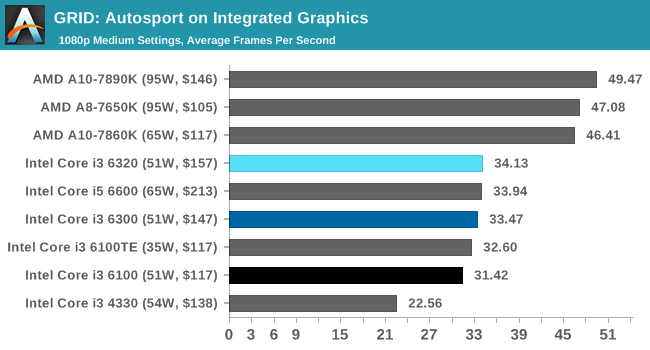
![GRID: Autosport on Integrated Graphics [Minimum FPS]](https://images.anandtech.com/graphs/graph10543/83073.png)
The difference between the APUs and Intel CPUs again shows up to a 33-50% difference in frame rates, to the point where at 1080p medium the integrated graphics do not break the minimum 30 FPS barrier. The GPU frequency and L3 cache again shows up the i3-6100 compared to the i3-6300.
Discrete Graphics

![GRID: Autosport on ASUS R7 240 DDR3 2GB ($70) [Minimum FPS]](https://images.anandtech.com/graphs/graph10543/83081.png)
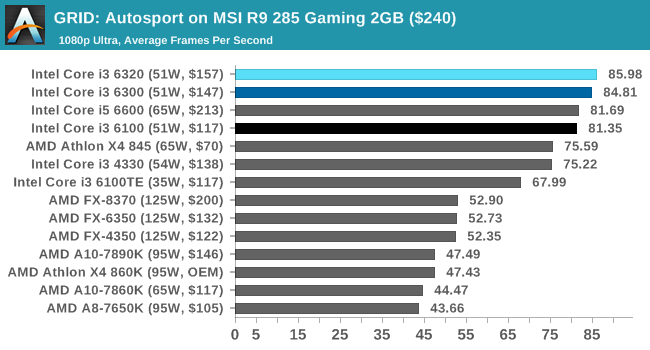
![GRID: Autosport on MSI R9 285 Gaming 2GB ($240) [Minimum FPS]](https://images.anandtech.com/graphs/graph10543/83089.png)
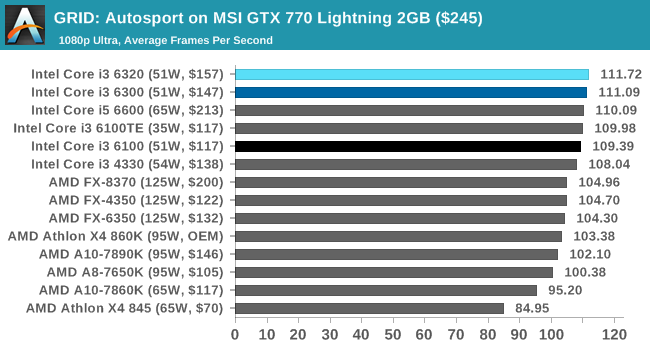
![GRID: Autosport on MSI GTX 770 Lightning 2GB ($245) [Minimum FPS]](https://images.anandtech.com/graphs/graph10543/83097.png)
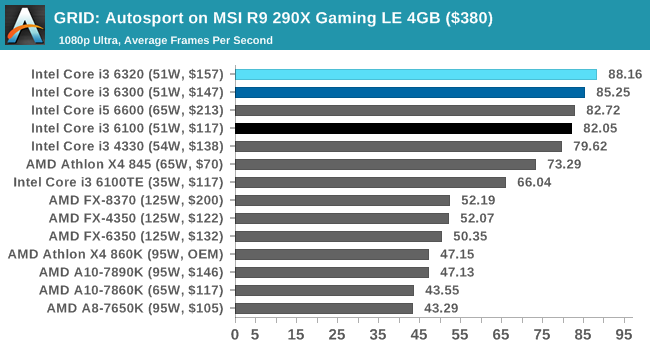
![GRID: Autosport on MSI R9 290X Gaming LE 4GB ($380) [Minimum FPS]](https://images.anandtech.com/graphs/graph10543/83105.png)
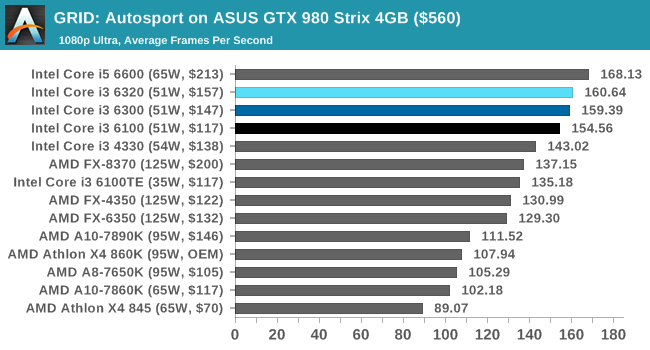
![GRID: Autosport on ASUS GTX 980 Strix 4GB ($560) [Minimum FPS]](https://images.anandtech.com/graphs/graph10543/83115.png)
With the discrete GPUs, there are multiple avenues to take with this analysis.
On the low-end cards, the choice of CPU makes little difference in our tests.
On the mid-range and high-end cards, the power of the CPU makes more of an effect with AMD discrete cards than NVIDIA discrete cards, except with the AMD Athlon X4 845 in play. When using an AMD discrete card with a mid-range GPU, the X4 845 plays well enough with the i3 parts for its price, but falls away a bit more on the high-end AMD discrete GPU. With NVIDIA GPUs, the Athlon X4 845 sits at the bottom and the main challengers are the FX parts.
So for EGO engine rules, it would seem to be:
AMD Carrizo CPU + AMD discrete GPU is OK, the lower powered the GPU the better.
AMD FX CPU + NVIDIA discrete GPU is OK
Intel CPU + any discrete GPU works well.
One could attest the differences between the discrete GPU choices to driver implementation, IPC, or how each GPU company focuses in optimizing for each game at hand (frequency vs threads vs caches).











94 Comments
View All Comments
junky77 - Tuesday, August 9, 2016 - link
No DX12 comparison?Meteor2 - Tuesday, August 9, 2016 - link
Another good point!BrokenCrayons - Tuesday, August 9, 2016 - link
Ian mentioned in the article that they're still using their 2015 game benchmark suite for this review. I would expect AT's 2016 benchmark list, once finalized, will include more DX12 titles. I'm not sure when those benchmarks are normally confirmed since I've never really given it much thought, but as we're wading into August, one would hope that the 2016 list will be as forward-looking as possible. However, they'll probably need to keep something from the 2015 list in order to have a comparative basis for new and old products. It's also important to retain a DX11 title or two as the older version of the API is very much alive and well at the moment.jeffry - Tuesday, August 9, 2016 - link
I think if your running an oced Sandy-Bridge (2500K) and you use your pc for gaming, its not worth the upgrade cost. Perhaps its worth to upgrade for the very high-end games with maxed out resolution and graphics features, but then id not pick an i3 (-> i7 instead).If you run simulations or any kind of HPC, you most likely have another setup anyways.
jeffry - Tuesday, August 9, 2016 - link
95% of all pp are shopping on a budget anyways, so i would spend my bucks on a new GPU instead of CPU, eg AMD Polaris or Nvidia Pascal GPU.Death666Angel - Tuesday, August 9, 2016 - link
https://www.youtube.com/watch?v=frNjT5R5XI4 You can get quite a few frames more with a modern, equally overclocked CPU. If you have the budget or get a good deal, an i7-3770k seems to be a good upgrade without having to get a completely new system with motherboard and RAM. Can be the difference between 45fps and 60fps.Voldenuit - Tuesday, August 9, 2016 - link
Thanks for the review Ian.A bit perplexed at the choice of GPUs and CPUs and game titles tested in this review.
The Core i5-2500K is a natural point of comparison since so many people are still on it. Though they are unlikely to switch to an i3 Skylake, still a useful comparison for a data point.
Those GPUs are really old. Someone building a new Skylake system would most likely be getting a 480 or 1060. Also, it would be useful to know if the i3 is bottlenecking games from reaching high framerates on 120/144 Hz monitors.
Which brings us to the choice of games. Following (in my opinion, somewhat dubious) claims by various youtube reviewers that even a skylake i5 is not sufficient for 144 Hz gaming, I'd like to know if an i3 is a bottleneck on games where framerates matter: Overwatch, DOOM, Crysis 3, Battlefield 4, etc. As well as games that stress the number of CPU cores like AOTS, TW:WH, etc.
Icehawk - Tuesday, August 9, 2016 - link
They run their benches w/o V-sync... so monitor Hz doesn't matter, you can see the maximum frame rates.I agree, some slightly newer GPUs would be good - at least a 470 or something.
leopard_jumps - Monday, August 15, 2016 - link
i3 6100 + RX 470 4GB ($200) will make $550 gaming PCleopard_jumps - Monday, August 15, 2016 - link
PCPartPicker part list: http://pcpartpicker.com/list/gfHsXHPrice breakdown by merchant: http://pcpartpicker.com/list/gfHsXH/by_merchant/
CPU: Intel Core i3-6100 3.7GHz Dual-Core Processor ($110.99 @ SuperBiiz)
Motherboard: ASRock Z170M Pro4S Micro ATX LGA1151 Motherboard ($77.98 @ Newegg)
Memory: G.Skill Ripjaws V Series 8GB (2 x 4GB) DDR4-2800 Memory ($40.98 @ Newegg)
GPU Asus Strix RX 470 4GB - $200
Storage: Western Digital Caviar Blue 1TB 3.5" 7200RPM Internal Hard Drive ($47.49 @ OutletPC)
Case: Deepcool TESSERACT SW ATX Mid Tower Case ($39.99 @ SuperBiiz)
Power Supply: EVGA 500W 80+ Bronze Certified ATX Power Supply ($43.99 @ SuperBiiz)
Total: $561.42
Prices include shipping, taxes, and discounts when available
Generated by PCPartPicker 2016-08-15 13:01 EDT-0400